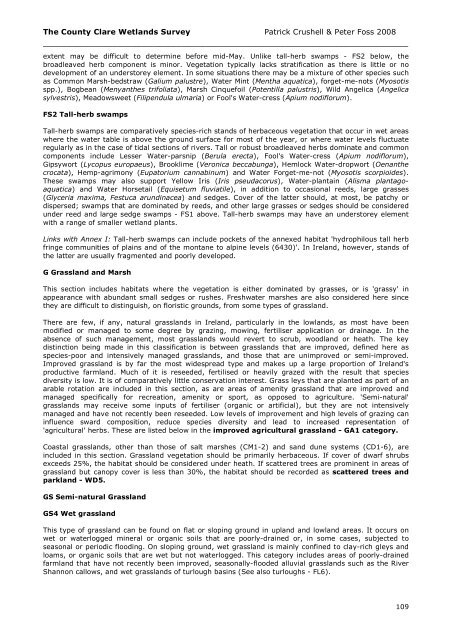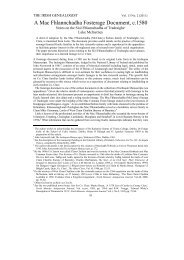Report Cover Vol I - Clare County Library
Report Cover Vol I - Clare County Library
Report Cover Vol I - Clare County Library
You also want an ePaper? Increase the reach of your titles
YUMPU automatically turns print PDFs into web optimized ePapers that Google loves.
The <strong>County</strong> <strong>Clare</strong> Wetlands Survey Patrick Crushell & Peter Foss 2008<br />
_______________________________________________________________<br />
extent may be difficult to determine before mid-May. Unlike tall-herb swamps - FS2 below, the<br />
broadleaved herb component is minor. Vegetation typically lacks stratification as there is little or no<br />
development of an understorey element. In some situations there may be a mixture of other species such<br />
as Common Marsh-bedstraw (Galium palustre), Water Mint (Mentha aquatica), forget-me-nots (Myosotis<br />
spp.), Bogbean (Menyanthes trifoliata), Marsh Cinquefoil (Potentilla palustris), Wild Angelica (Angelica<br />
sylvestris), Meadowsweet (Filipendula ulmaria) or Fool's Water-cress (Apium nodiflorum).<br />
FS2 Tall-herb swamps<br />
Tall-herb swamps are comparatively species-rich stands of herbaceous vegetation that occur in wet areas<br />
where the water table is above the ground surface for most of the year, or where water levels fluctuate<br />
regularly as in the case of tidal sections of rivers. Tall or robust broadleaved herbs dominate and common<br />
components include Lesser Water-parsnip (Berula erecta), Fool's Water-cress (Apium nodiflorum),<br />
Gipsywort (Lycopus europaeus), Brooklime (Veronica beccabunga), Hemlock Water-dropwort (Oenanthe<br />
crocata), Hemp-agrimony (Eupatorium cannabinum) and Water Forget-me-not (Myosotis scorpioides).<br />
These swamps may also support Yellow Iris (Iris pseudacorus), Water-plantain (Alisma plantagoaquatica)<br />
and Water Horsetail (Equisetum fluviatile), in addition to occasional reeds, large grasses<br />
(Glyceria maxima, Festuca arundinacea) and sedges. <strong>Cover</strong> of the latter should, at most, be patchy or<br />
dispersed; swamps that are dominated by reeds, and other large grasses or sedges should be considered<br />
under reed and large sedge swamps - FS1 above. Tall-herb swamps may have an understorey element<br />
with a range of smaller wetland plants.<br />
Links with Annex I: Tall-herb swamps can include pockets of the annexed habitat 'hydrophilous tall herb<br />
fringe communities of plains and of the montane to alpine levels (6430)'. In Ireland, however, stands of<br />
the latter are usually fragmented and poorly developed.<br />
G Grassland and Marsh<br />
This section includes habitats where the vegetation is either dominated by grasses, or is 'grassy' in<br />
appearance with abundant small sedges or rushes. Freshwater marshes are also considered here since<br />
they are difficult to distinguish, on floristic grounds, from some types of grassland.<br />
There are few, if any, natural grasslands in Ireland, particularly in the lowlands, as most have been<br />
modified or managed to some degree by grazing, mowing, fertiliser application or drainage. In the<br />
absence of such management, most grasslands would revert to scrub, woodland or heath. The key<br />
distinction being made in this classification is between grasslands that are improved, defined here as<br />
species-poor and intensively managed grasslands, and those that are unimproved or semi-improved.<br />
Improved grassland is by far the most widespread type and makes up a large proportion of Ireland's<br />
productive farmland. Much of it is reseeded, fertilised or heavily grazed with the result that species<br />
diversity is low. It is of comparatively little conservation interest. Grass leys that are planted as part of an<br />
arable rotation are included in this section, as are areas of amenity grassland that are improved and<br />
managed specifically for recreation, amenity or sport, as opposed to agriculture. 'Semi-natural'<br />
grasslands may receive some inputs of fertiliser (organic or artificial), but they are not intensively<br />
managed and have not recently been reseeded. Low levels of improvement and high levels of grazing can<br />
influence sward composition, reduce species diversity and lead to increased representation of<br />
'agricultural' herbs. These are listed below in the improved agricultural grassland - GA1 category.<br />
Coastal grasslands, other than those of salt marshes (CM1-2) and sand dune systems (CD1-6), are<br />
included in this section. Grassland vegetation should be primarily herbaceous. If cover of dwarf shrubs<br />
exceeds 25%, the habitat should be considered under heath. If scattered trees are prominent in areas of<br />
grassland but canopy cover is less than 30%, the habitat should be recorded as scattered trees and<br />
parkland - WD5.<br />
GS Semi-natural Grassland<br />
GS4 Wet grassland<br />
This type of grassland can be found on flat or sloping ground in upland and lowland areas. It occurs on<br />
wet or waterlogged mineral or organic soils that are poorly-drained or, in some cases, subjected to<br />
seasonal or periodic flooding. On sloping ground, wet grassland is mainly confined to clay-rich gleys and<br />
loams, or organic soils that are wet but not waterlogged. This category includes areas of poorly-drained<br />
farmland that have not recently been improved, seasonally-flooded alluvial grasslands such as the River<br />
Shannon callows, and wet grasslands of turlough basins (See also turloughs - FL6).<br />
109
















